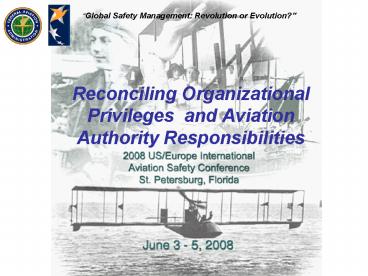Reconciling Organizational Privileges and Aviation Authority Responsibilities PowerPoint PPT Presentation
Title: Reconciling Organizational Privileges and Aviation Authority Responsibilities
1
Reconciling Organizational Privileges and
Aviation Authority Responsibilities
2
Major Discussion Points
- This session discussed three approved design
organization systems - EASA Design Organization Approval (DOA)
- TCCA Accredited Design Organization (ADO)
- FAA Certified Design Organization (CDO)
- Each regulatory body defined their system and
discussed similarities and differences - The three systems are in various stages of
maturity but all are based on a company and
regulatory body safety culture.
3
Major Discussion Points
- Similarities between the three systems
- Greater focus on process management and system
oversight - Design Organizations responsible for all
compliance determinations - Authority performs project and system oversight
- Routine projects require little authority
involvement - Suppliers can be incorporated with proper
oversight - Certificate issued by authority
4
Major Discussion Points
Differences between the three systems
5
Major Discussion Points
- SMS must have an organization behind it. This is
different from delegation. - Knowledge, privileges and competencies go
together. - Rating system with privileges defined.
- Design organization is 100 responsible for its
compliance. - Quality, safety and compliance go together and
are embedded in a seamless system.
6
Reaction from the Floor
- Summarized into three general categories
- Scope of these design organizations
- Mandatory or not?
- Certificated or delegated and does this mean
findings or showings or both? - Culture
- How do we prepare the regulatory bodies for the
changes of roles and responsibilities? - System oversight vs discrete findings
- Internal risk based models to help decision
making - Global integration
- System to system compatibility
- Production approvals so parts can move between
systems
7
Outcomes/Additional Ideas
- All three agencies emphasized that their systems
are under further review. - Feedback from industry through industry
groups/forums will be considered as these systems
are further developed.
PowerShow.com is a leading presentation sharing website. It has millions of presentations already uploaded and available with 1,000s more being uploaded by its users every day. Whatever your area of interest, here you’ll be able to find and view presentations you’ll love and possibly download. And, best of all, it is completely free and easy to use.
You might even have a presentation you’d like to share with others. If so, just upload it to PowerShow.com. We’ll convert it to an HTML5 slideshow that includes all the media types you’ve already added: audio, video, music, pictures, animations and transition effects. Then you can share it with your target audience as well as PowerShow.com’s millions of monthly visitors. And, again, it’s all free.
About the Developers
PowerShow.com is brought to you by CrystalGraphics, the award-winning developer and market-leading publisher of rich-media enhancement products for presentations. Our product offerings include millions of PowerPoint templates, diagrams, animated 3D characters and more.

